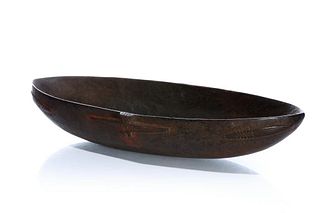Apulian Red Figure Lidded Lekanis, Baltimore Painter
Lot 66
About Seller
Artemis Fine Arts
686 S Taylor Ave, Ste 106
Louisville, CO 80027
United States
Selling antiquities, ancient and ethnographic art online since 1993, Artemis Gallery specializes in Classical Antiquities (Egyptian, Greek, Roman, Near Eastern), Asian, Pre-Columbian, African / Tribal / Oceanographic art. Our extensive inventory includes pottery, stone, metal, wood, glass and textil...Read more
Categories
Estimate:
$4,500 - $6,500
Absentee vs Live bid
Two ways to bid:
- Leave a max absentee bid and the platform will bid on your behalf up to your maximum bid during the live auction.
- Bid live during the auction and your bids will be submitted real-time to the auctioneer.
Bid Increments
| Price | Bid Increment |
|---|---|
| $0 | $25 |
| $300 | $50 |
| $1,000 | $100 |
| $2,000 | $250 |
| $5,000 | $500 |
| $10,000 | $1,000 |
| $20,000 | $2,500 |
| $50,000 | $5,000 |
| $100,000 | $10,000 |
| $200,000 | $20,000 |
About Auction
By Artemis Fine Arts
Jun 10, 2021
Set Reminder
2021-06-10 10:00:00
2021-06-10 10:00:00
America/New_York
Bidsquare
Bidsquare : Exceptional Antiquities | Asian | Ethnographic
https://www.bidsquare.com/auctions/artemis-gallery/exceptional-antiquities-asian-ethnographic-7012
Museum-worthy examples of Egyptian, Greek, Roman, Viking, Near Eastern, Far East / Asian, Pre-Columbian, African / Tribal, Oceanic, Native American, Spanish Colonial, Russian, Fossils, Ancient Jewelry, Fine Art, so much more! Artemis Fine Arts info@artemisgallery.com
Museum-worthy examples of Egyptian, Greek, Roman, Viking, Near Eastern, Far East / Asian, Pre-Columbian, African / Tribal, Oceanic, Native American, Spanish Colonial, Russian, Fossils, Ancient Jewelry, Fine Art, so much more! Artemis Fine Arts info@artemisgallery.com
- Lot Description
Magna Graecia, South Italic Colonies, Apulia, attributed to the Baltimore Painter, ca. 330 to 310 BCE. A wheel-thrown pottery lidded vessel known as a lekanis that is covered in black pigment and decorated with gorgeous red-figure details. The base presents with a flared foot beneath a hemispherical body that is enveloped in lustrous black pigment and has a pair of parabolic handles protruding from the side walls. The interior of the basin has developed incredible areas of rainbow iridescence that nicely contrast against the black ground. The wide, bell-shaped lid bears a register of cresting waves along the exterior rim and a radiating flower atop the discoid handle. Two distinguished 'lady of fashion' characters adorn the top of the lid, one in profile and the other in portrait, both wearing delicate stephane brought forth in fugitive white pigment and kekryphalos hairstyles bound in the back. The grounds surrounding the women are filled with abstract foliate forms and flowers, and a grand pair of palmettes separate the two luxurious ladies. Size (w/ lid): 9.25" W x 5.875" H (23.5 cm x 14.9 cm)
According to A.D. Trendall, "The Baltimore Painter is the most important and significant of the later Apulian vase-painters and, in view of the fact that many of his vases and those of his associates come from the area around Canosa, it is likely that his workshop was located in that city. His vases have much in common with those of his Tarentine contemporary, the Underworld Painter, particularly in regard to their subject-matter, monumental dimensions, multi-figured compositions, and ornamental patterns, but they differ greatly in the drawing of the faces and in the rendering of the drapery, in both of which the Baltimore Painter is much bolder and more assertive." (A.D. Trendall "Red Figure Vases of South Italy and Sicily" Thames and Hudson, 1989, p. 97)
Lidded lekanides were cosmetic containers, often given by fathers to brides on their wedding day. The lady of fashion motif complements this notion - often thought to represent a young woman on the day of her betrothal.
Cf. A lepaste painted by the Baltimore Painter at The British Museum, museum number 1859,0216.81
This piece has been searched against the Art Loss Register database and has been cleared. The Art Loss Register maintains the world’s largest database of stolen art, collectibles, and antiques.
Provenance: private New York, New York, USA collection; ex-private C.H. collection, Lower Saxony, Germany, acquired between the 1960s and 1987
All items legal to buy/sell under U.S. Statute covering cultural patrimony Code 2600, CHAPTER 14, and are guaranteed to be as described or your money back.
A Certificate of Authenticity will accompany all winning bids.
We ship worldwide and handle all shipping in-house for your convenience.
#164552Small nicks to rim of lid and body, with abrasions and fading to pigment, otherwise intact and excellent. Great root marks inside lid, lovely craquelure in basin of body, as well as silvery iridescence on body exterior and rainbow iridescence on basin surfaces. Old inventory label beneath foot.Condition
- Shipping Info
-
All shipping is handled in-house for your convenience. Your invoice from Artemis Gallery will include shipping calculation instructions. If in doubt, please inquire BEFORE bidding for estimated shipping costs for individual items.
-
- Buyer's Premium



 EUR
EUR CAD
CAD AUD
AUD GBP
GBP MXN
MXN HKD
HKD CNY
CNY MYR
MYR SEK
SEK SGD
SGD CHF
CHF THB
THB















